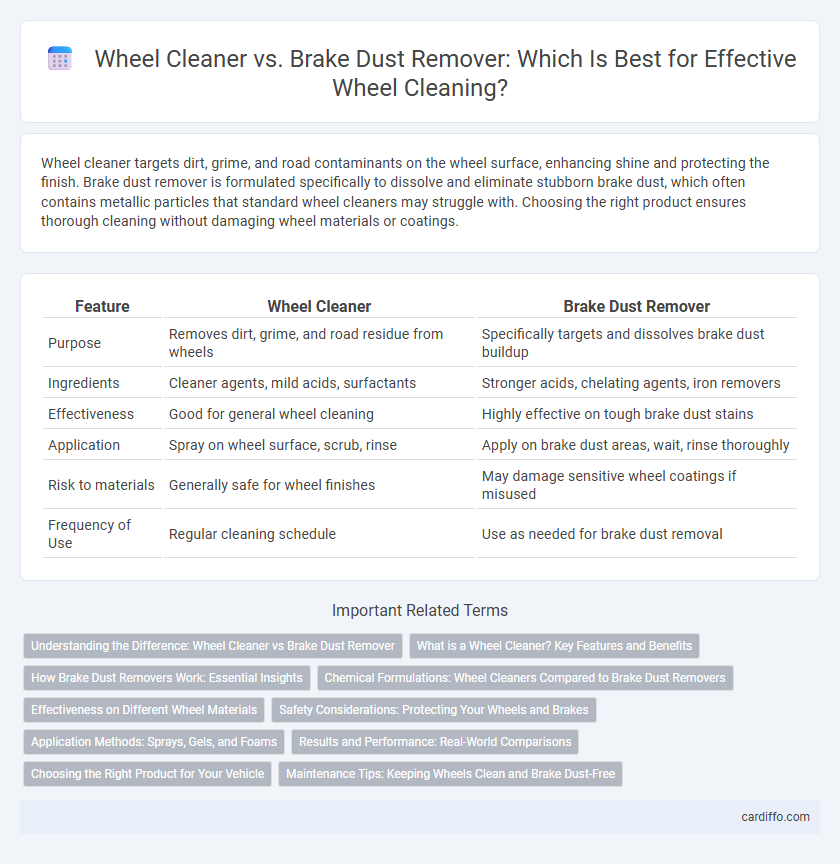Wheel cleaner targets dirt, grime, and road contaminants on the wheel surface, enhancing shine and protecting the finish. Brake dust remover is formulated specifically to dissolve and eliminate stubborn brake dust, which often contains metallic particles that standard wheel cleaners may struggle with. Choosing the right product ensures thorough cleaning without damaging wheel materials or coatings.
Table of Comparison
| Feature | Wheel Cleaner | Brake Dust Remover |
|---|---|---|
| Purpose | Removes dirt, grime, and road residue from wheels | Specifically targets and dissolves brake dust buildup |
| Ingredients | Cleaner agents, mild acids, surfactants | Stronger acids, chelating agents, iron removers |
| Effectiveness | Good for general wheel cleaning | Highly effective on tough brake dust stains |
| Application | Spray on wheel surface, scrub, rinse | Apply on brake dust areas, wait, rinse thoroughly |
| Risk to materials | Generally safe for wheel finishes | May damage sensitive wheel coatings if misused |
| Frequency of Use | Regular cleaning schedule | Use as needed for brake dust removal |
Understanding the Difference: Wheel Cleaner vs Brake Dust Remover
Wheel cleaner is formulated to remove general dirt, grime, and road contaminants from wheels, while brake dust remover specifically targets the fine metallic particles deposited by brake pads. Brake dust removers often contain stronger chemical agents designed to dissolve stubborn brake residue without damaging wheel finishes. Understanding the distinction ensures effective cleaning and protects wheel surfaces from corrosion or staining.
What is a Wheel Cleaner? Key Features and Benefits
A wheel cleaner is a specialized automotive product designed to remove dirt, grime, and brake dust from alloy and steel wheels without damaging the finish. Key features include pH-balanced formulas, corrosion inhibitors, and compatibility with various wheel types, ensuring effective and safe cleaning. Benefits of using a wheel cleaner include enhanced wheel appearance, prevention of brake dust buildup, and extended wheel lifespan through protective cleaning agents.
How Brake Dust Removers Work: Essential Insights
Brake dust removers use specialized chemical agents, such as chelating agents and mild acids, to break down the iron particles and grime embedded in brake dust on wheel surfaces. These formulations are designed to react with the metallic components, turning the dust into a colorless, water-soluble compound that can be easily rinsed away, preventing corrosion and maintaining wheel appearance. Unlike general wheel cleaners, brake dust removers target the stubborn, baked-on iron residues specific to braking systems, providing a deeper clean and protecting the finish.
Chemical Formulations: Wheel Cleaners Compared to Brake Dust Removers
Wheel cleaners typically contain mild acids such as citric acid or glycolic acid combined with surfactants to effectively break down road grime and brake dust without damaging the wheel finish. In contrast, brake dust removers often feature stronger chelating agents like ethylenediaminetetraacetic acid (EDTA) and more potent acids to dissolve iron particles embedded in the dust. The chemical formulation of brake dust removers is designed to target stubborn metallic contaminants, whereas wheel cleaners balance cleaning power with surface protection for various wheel materials.
Effectiveness on Different Wheel Materials
Wheel cleaner formulations are designed to effectively remove general dirt and grime from various wheel materials such as alloy, chrome, and painted surfaces without causing damage. Brake dust removers specifically target stubborn brake dust deposits, often containing stronger chemicals optimized for metallic and powder-coated wheels, but they may be too harsh for delicate finishes like polished or clear-coated surfaces. Selecting the appropriate product based on wheel material ensures both thorough cleaning and preservation of the wheel's finish.
Safety Considerations: Protecting Your Wheels and Brakes
Wheel cleaner formulations prioritize gentle, non-corrosive chemicals to prevent damage to wheel finishes, while brake dust removers often contain stronger agents designed to break down stubborn metallic particles. Using a brake dust remover without proper safety measures or on delicate wheel surfaces can lead to corrosion or discoloration, highlighting the importance of selecting products compatible with your wheel materials. Protecting both wheels and brake components requires following manufacturer guidelines and using gloves and eye protection to avoid chemical exposure during cleaning.
Application Methods: Sprays, Gels, and Foams
Wheel cleaners and brake dust removers vary in application methods, typically available as sprays, gels, or foams for targeted cleaning. Sprays provide quick coverage and easy access to intricate wheel designs, while gels adhere to vertical surfaces, allowing longer dwell time for breaking down stubborn brake dust. Foams expand to reach deep crevices, maximizing contact with contaminants and enhancing the overall cleaning efficiency.
Results and Performance: Real-World Comparisons
Wheel cleaner effectively removes surface dirt and road grime, enhancing tire appearance with minimal effort, while brake dust remover targets stubborn metallic particles embedded in rims, providing deeper cleaning for brake-related residues. In real-world applications, brake dust removers demonstrate superior performance on alloy and painted wheels by restoring shine and preventing corrosion without damaging finish integrity. Consistent use of specialized brake dust remover yields longer-lasting clean results compared to general wheel cleaners, particularly in high-performance or daily-driven vehicles facing heavy braking conditions.
Choosing the Right Product for Your Vehicle
Wheel cleaners and brake dust removers serve distinct purposes; wheel cleaners target general dirt, grime, and road contaminants, while brake dust removers specifically combat the fine metallic particles deposited by braking systems. Selecting the right product requires assessing your vehicle's wheel material, as abrasive formulas may damage delicate finishes like alloy or chrome. For optimal results, use a pH-balanced cleaner suited to your wheel type and ensure the brake dust remover is formulated to dissolve stubborn particles without harming the protective wheel coating.
Maintenance Tips: Keeping Wheels Clean and Brake Dust-Free
Regularly applying a dedicated wheel cleaner helps prevent brake dust buildup by breaking down grime and road contaminants effectively. Using a specialized brake dust remover targets stubborn deposits on rims and calipers, ensuring optimal brake performance and extending component lifespan. Consistent maintenance with these products protects wheel finishes and enhances vehicle appearance while reducing corrosion risks.
Wheel cleaner vs Brake dust remover Infographic

 cardiffo.com
cardiffo.com